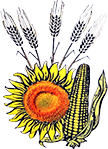PGR Treated Winter Wheat Genotypes Behavior to Different Rates of Nitrogen Application
Adina Varadi1, Diana Hirişcău1, Rozalia Kadar1, Ionuţ Racz1,2
1Staţiunea de Cercetare-Dezvoltare Agricolă Turda
2Universitatea de Ştiințe Agricole şi Medicină Veterinară Cluj-Napoca
Keywords: grain protein content, nitrogen fertilization, winter wheat, yield, plant height.
Abstract: Winter wheat (Triticum aestivum L.) is one of the main cereal crops cultivated on Earth. It provides basic food for half of Earth population that is why the preoccupation for increasing grain yield and grain quality is a primary concern.
Nitrogen fertilization is the most important factor for plant growth and development which can increase yield and grain quality. But the high rates of applied nitrogen fertilizer combined with high precipitations favor stem elongation and increase risk of cereal lodging. Lodging is a common phenomenon that occurs near harvest time, which can significant decrease both quantity and quality of the yield.
Plant growth regulators (PGRs) such as retardants are widely used for lodging control in winter wheat due to their effect of reducing plant height.
In order to study the effects of PGR treatment and different nitrogen fertilization rates on plant height, lodging resistance, grain yield and grain protein content of winter wheat, an experiment was initiated in 2015 at Agricultural Research and Development Station Turda using eight Romanian winter wheat genotypes tested at different rates of applied nitrogen fertilizer, in combination with foliar treatment with trinexapac-ethyl based plant growth regulator (PGR) sprayed over the foliage, in a three years field experiment (2015-2016, 2018-2019 and 2019-2020).
Results showed that high rates of applied nitrogen fertilizer and high rainfall stimulated stem elongation and increase the risk of cereal lodging. The trinexapac-ethyl application on wheat cause shorter plants and less lodging.
On yield and grain protein content nitrogen fertilization had a bigger influence than the trinexapac-ethyl treatment, both yield and grain protein content increase as the amount of nitrogen fertilizer applied was higher.
